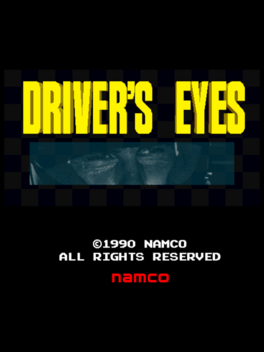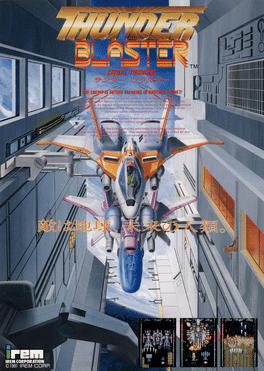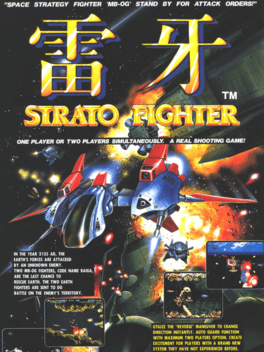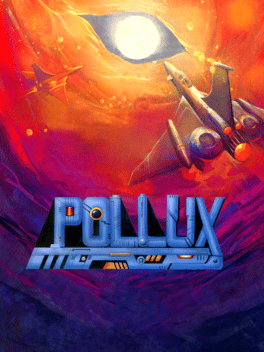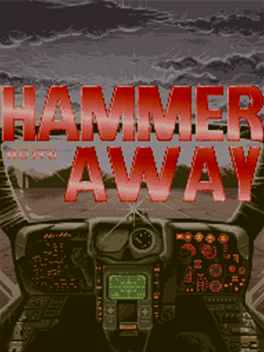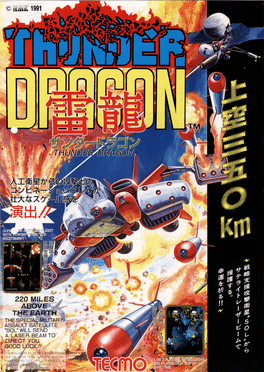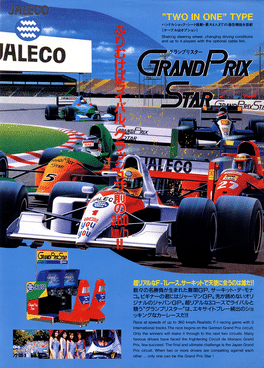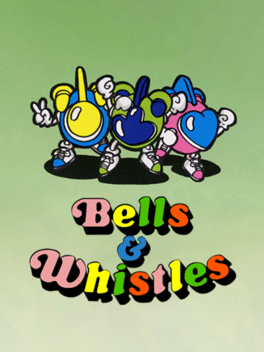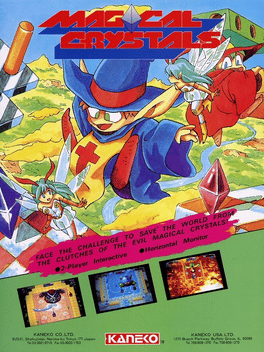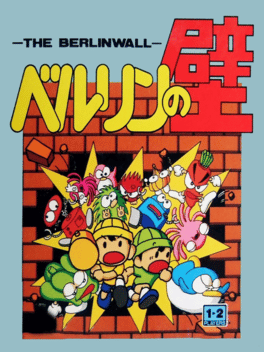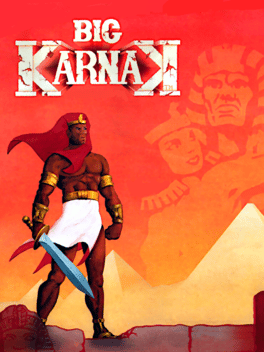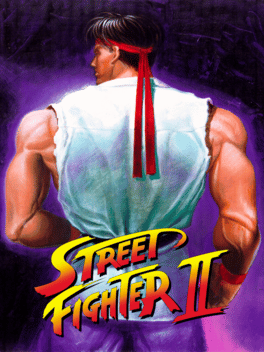New Arcade Games - Page 83
-
Driver's Eyes
1991
Driver's Eyes
1991
Driver's Eyes is a 1991 3D driving simulation arcade game developed and published in Japan by Namco. -
Strike Force
1991
Strike Force
1991
Side scrolling action shooter. Shoot the aliens and rescue colonists from various planets. Defeat the alien mothership with the special weapons you collect. -
Lethal Thunder
1991
Lethal Thunder
1991
A simple shoot-em-up with multiple endings based on your performance in each level. Your guns build up power and get stronger as you tap the fire button rapidly, but the power gauge will drain if you stop tapping the button. After charging up enough power, you can press the bomb button for a smart bomb attack which uses up the whole power gauge. With more power it creates a bigger explosion. Power-ups switch your weapon to fire different projectiles, like lasers that spread out at right angles, and a flamethrower that reaches farther with more power. -
Thunder Cross II
1991
Thunder Cross II
1991
Thunder Cross II is an Action game, developed and published by Konami, which was released in 1991. -
Strato Fighter
1991
Strato Fighter
1991
Strato Fighter, otherwise known as Raiga: Strato Fighter, is a 1991 video arcade game developed by Tecmo. It is a horizontal side-scrolling space shooter in which two players may play simultaneously. The game sets players in the year 2135 on a mission to save the Earth from colony-based, militant alien invaders using the MB-OG Raiga (Thunder Fang). The Raiga has the ability to spin around to attack enemies from behind. Power-ups can be obtained by destroying container ships. The craft's weapons include the Shotgun, Ion launcher, Vertical, Homing Missiles and Bomb attacks along with items such as Speed Ups, Shields and Extends. The spacecraft can also obtain an Option weapon called the Auto Guard; three types of Auto Guards were available such as the target locking Beam Rifle, the powerful Solid Shooter and the standard Blaster item. -
Bowl-O-Rama
1991
Bowl-O-Rama
1991
This upgrade for a different Capcom bowling title contains three variations of bowling games. Some machines dispense tickets. -
Pollux
1991
Pollux
1991
Pollux is a vertical scrolling shooter arcade game. It was developed by Dooyong and published by Atlus, released only in Asian arcades in 1991. As a part of mankind’s future space development project, an enormous, automated space station called Pollux is developed. Pollux is equipped with an artificial brain that acquires so much intelligence that it makes its own personality, gender and exceeds the minds of its creators. However, Pollux starts to dwell on the thought of evil so much that it starts attacking those it was supposed to service. The player assumes control of a space fighter pilot assigned to destroy Pollux before it takes any more lives. -
Hacha Mecha Fighter
1991
-
Hammer Away
1991
Hammer Away
1991
Hammer Away is an unreleased arcade shoot ’em up game for the System-18, which was being developed by Santos in partnership with SEGA in around 1990-1991. It was intended to be launched in ’91, but ultimately never made its way to arcades for unknown reasons. -
Hard Head 2
1991
Hard Head 2
1991
Hard Head 2 is a much more reasonably assembled platformer than its predecessor, which almost makes it more boring. Luckily, the visual design is still crazy as hell. A damsel in distress waits to be rescued, here it is a hippy chick that got captured by the devil while dancing with Hard Head. In between levels, the devil joyfully chews on her, while the hero runs around in panic, mumbling stuff in hilarious Konglish. -
Hasamu
1991
-
Gulf Storm
1991
Gulf Storm
1991
A politically somewhat explosive theme at the time, the player in Gulf Storm assumes the role of a military officer on the hunt for the worst Saddam Hussein double ever. On that mission, he doesn't settle with a simple plane, but switches between a speedboat, a helicopter and a motorcycle, all the while wondering where the Iraqi found all those biplanes in 1991. -
Thunder Zone
1991
Thunder Zone
1991
Desert Assault or Thunder Zone is a isometric scrolling military themed shoot 'em up game where you take control of one of four commandos operating in the Persian gulf. Each commando has their own look and special limited bomb. As you walk through the stages you fight a variety of enemies on foot, vehicles, static guns and bosses. While playing destroyed enemies drop weapons and items to restore hit points that can be picked up. Weapons include a shotgun, machinegun, bazooka, rocket launcher and flamethrower. Sometimes a vehicle must be mounted. These include a car and some kind of desert/snowmobile. There are two and four player versions. In the slightly different Japanese version the second stage takes place in the Artic while in the other versions the second stage takes place in the desert. -
Thunder Dragon
1991
Thunder Dragon
1991
A one or two player shooter game published by NMK Co. Ltd. in 1991, developed by NMK Co. Ltd. -
Grand Prix Star
1991
-
Bells & Whistles
1991
Bells & Whistles
1991
Detana!! TwinBee is a vertically scrolling shoot 'em up game following the same conventions established in the original TwinBee, where players assume the role of Light and Pastel taking control of TwinBee and WinBee across seven levels to defeat invading forces of the evil alien Iva and save planet Meru. -
Magical Crystals
1991
Magical Crystals
1991
A cute top-down action game where you control a wizard that must rescue fairies who are trapped inside of crystals. -
The Berlin Wall
1991
The Berlin Wall
1991
The Berlin Wall is a platform arcade game. The player takes control of a boy who must use his hammer to break the blocks that form part of the platform levels that form each stage. These holes act as traps for the many patrolling monsters and once one has fallen into a hole, the player may then use the hammer on the monster to make it fall through the hole and down to the platform below - causing it to change into fruit or power-ups, which can then be collected. -
Big Karnak
1991
Big Karnak
1991
Big Karnak is a scrolling platform "Hack and slash" arcade game released in 1991 by Gaelco. The game takes place in an Ancient Egypt setting. You control a pharoh that attempts to fight through several different levels fighting deadly enemies like cobras and scorpions. -
Street Fighter II
1991
Street Fighter II
1991
star 8.2A sequel to Street Fighter, Street Fighter II improved upon the many concepts introduced in the first game, including the use of command-based special moves and a six-button configuration, while offering players a selection of multiple playable characters, each with their own unique fighting style and special moves. Street Fighter II is credited for starting the fighting game boom during the 1990s. Its success led to the production of several updated versions, each offering additional features and characters over previous versions, as well as many home versions. Some of the home versions of the Street Fighter II games have sold millions of copies, with the SNES port of the first Street Fighter II being Capcom's best-selling consumer game of all-time as of 2008. Street Fighter II follows several of the conventions and rules already established by its original 1987 predecessor. The player engages opponents in one-on-one close quarter combat in a series of best-two-out-of-three matches. The objective of each round i
